
The grey-fronted dove is a large New World tropical dove. It is found on Trinidad and in every mainland South American country except Chile.

The grey-headed dove (Leptotila plumbeiceps) is a large New World dove. It is found from eastern Mexico to Colombia.

The white-throated quail-dove is a species of bird in the family Columbidae. It is found in Argentina, Bolivia, Colombia, Ecuador, and Peru.

The lined quail-dove is a species of bird in the family Columbidae. It is found in Colombia, Trinidad and Tobago, and Venezuela.

The sapphire quail-dove is a species of bird in the family Columbidae. It is found in Brazil, Colombia, Ecuador, and Peru.

The olive-backed quail-dove is a species of bird in the family Columbidae. It is found in Colombia, Costa Rica, Ecuador, Nicaragua, and Panama.
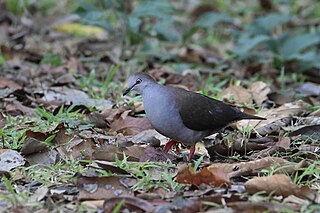
The grey-chested dove is a species of bird in the family Columbidae. It is found in Belize, Colombia, Costa Rica, Guatemala, Honduras, Mexico, Nicaragua, and Panama.
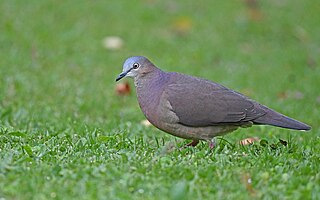
The Tolima dove is a species of bird in the family Columbidae. It is endemic to Colombia.
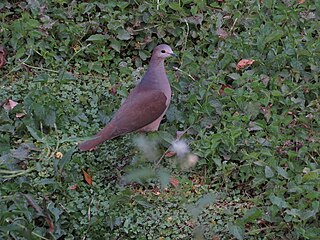
The Yungas dove, also known as the white-faced dove or large-tailed dove, is a species of bird in the family Columbidae. It is found in Argentina and Bolivia.

The pallid dove is a species of bird in the family Columbidae. It is found in Colombia, Ecuador, and Peru.

The bamboo foliage-gleaner, also known as the crested foliage-gleaner or dusky-cheeked foliage-gleaner, is a species of bird in the Furnariinae subfamily of the ovenbird family Furnariidae. It is found in Bolivia, Brazil, Colombia, Ecuador, and Peru.

The ochre-throated foliage-gleaner is a species of bird in the Furnariinae subfamily of the ovenbird family Furnariidae. It is found in Panama and every mainland South American country except Argentina, Chile, Paraguay, and Uruguay.
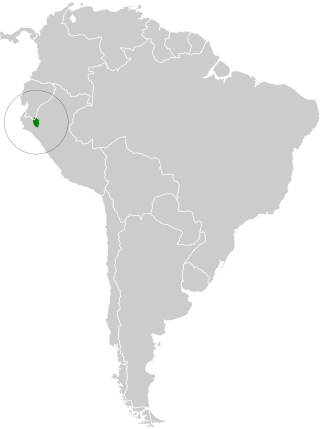
The Marañón crescentchest is a species of bird in the family Melanopareiidae. It is found in southern Ecuador and northern Peru.
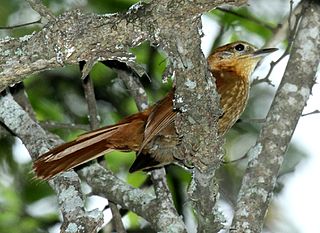
The rufous-necked foliage-gleaner is a Vulnerable species of bird in the Furnariinae subfamily of the ovenbird family Furnariidae. It is found in Ecuador and Peru.

The speckle-breasted wren is a species of bird in the family Troglodytidae. It is found in Colombia, Ecuador, and Peru.

The rufous-tailed xenops is a species of bird in the Furnariinae subfamily of the ovenbird family Furnariidae. It is found in Bolivia, Brazil, Colombia, Ecuador, Guyana, Peru, Suriname, Venezuela, and possibly French Guiana.

The ocellated woodcreeper is a species of bird in the subfamily Dendrocolaptinae of the ovenbird family Furnariidae. It is found in Bolivia, Brazil, Colombia, Ecuador, Peru, and Venezuela.
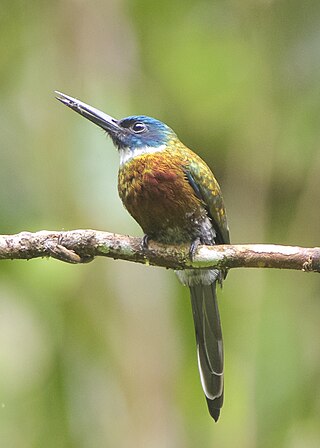
The purplish jacamar is a species of bird in the family Galbulidae. It is found in Brazil, Colombia, Ecuador, and Peru.
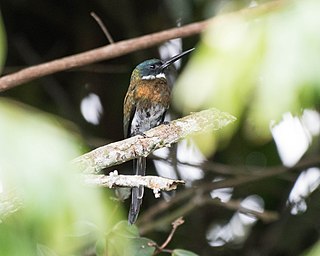
The bronzy jacamar is a species of bird in the family Galbulidae. It occurs in Bolivia, Brazil, Colombia, French Guiana, Guyana, Suriname, and Venezuela.

The black-tailed trogon is a species of bird in the family Trogonidae, the quetzals and trogons. It is found Panama and northern South America.























